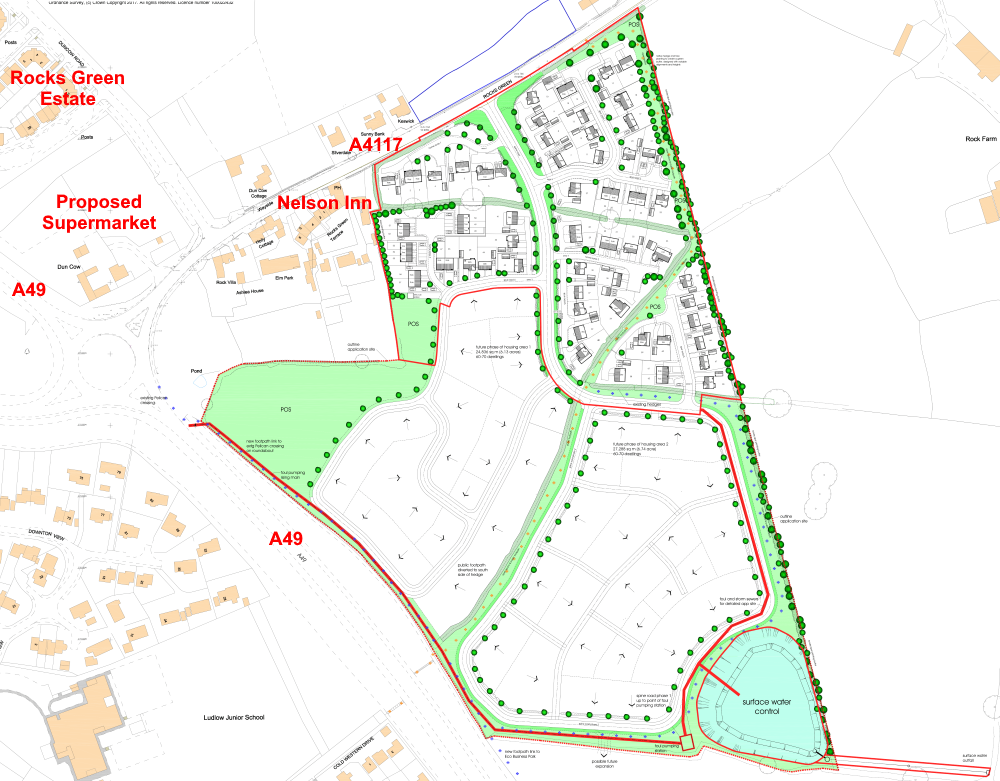Plans for 200 homes south of Rocks Green have met significant objections. Highways England has ordered that the scheme is not approved for at least three months while its concerns over analysis of traffic impacts are addressed. Shropshire Council’s conservation team has objected to the plans, which it describes as “disappointing”. The council’s ecologists have recommended that the development is refused unless more information on the impact on protected species is provided.
At the beginning of November, Pickstock Homes submitted a planning application for 200 homes behind the Nelson Inn (17/05189/FUL). The application is in outline for the full site and a full planning application for the first 68 of the homes.
Shropshire Council’s conservation team has recommended several changes to the scheme. It wants the layout of the houses at the site entrance to curve into the site.
The conservation officers also say the traditional design of the housing is “disappointing” and “pastiche”:
“Such sites should afford the opportunity for innovative contemporary design, which has been demonstrated to some extent at the Dun Cow Farm site nearby to the north-west of the site. Whilst Ludlow is historic in nature, it is forward thinking, innovative and has good eco-credentials, especially given the proximity of the eco-park, where innovative eco-technology should be demonstrated… It is important to make this site part of Rocks Green and for it not to be a standardised suburb of Ludlow.”
The conservation team had offered to discuss the design with the developer before the application was submitted:
“It is disappointing that this offer has not been taken up, as the overall design and layout of the proposed site is too generic and therefore not of a sufficient design standard in terms of it not adequately demonstrating sufficient local distinctiveness, that would also be detrimental to the setting of the adjacent heritage assets and the non-designated heritage assets in Rocks Green in particular.”
The conservation report concludes that the plans are not in accordance with paragraph 131 of the National Planning Policy Framework[1] as well as national planning policy guidance on appropriate design. The proposal also conflicts with local policies.[2] Conservation officers want a full planning application for the entire site “in order for the whole site to be considered and assessed in a more holistic manner” and “to aid the delivery of the site in a cohesive manner.”
In a second objection, Highways England has instructed that no decision is made on the planning application for three months. It has asked the applicant to improve several technical points in the highways impact assessment.
Shropshire Council’s biodiversity team has recommended that the scheme is refused because the developer hasn’t submitted sufficient information on bats, great crested newts, badgers and the impact on the environmental network. It wants bat surveys along with mitigation measures if needed. A pond east of the proposed development should be surveyed for great crested newts. This involves four survey visits between mid-March and mid-June or taking a water sample for eDNA testing between mid-April and mid-June. The developer needs to confirm that the site and its surroundings have been checked for badgers. Finally, officers note that the site lies in a buffer zone for an environmental corridor. They say the developer must clearly demonstrate how the development will promote the preservation, restoration and recreation of priority habitats and ecological networks.
Shropshire Council’s archaeologists have recommended that an archaeological evaluation is undertaken because the site has moderate to high archaeological potential. There has been one public objection to the scheme on traffic and ecology grounds. Ludford parish council has yet to comment.
None of the objections will kill the scheme off. The highways and ecological objections can be resolved with further analysis and some additional design work. The conservation objection is more fundamental and requires a rethink of the design of the scheme. However, it is not unknown for planning officers to overrule conservation objections.
It is probable that this scheme will go ahead but approval is likely to take several months.
Should be build another 1,000 homes in Ludlow?
Update 3 December 2017
Another criticism of this scheme has been lodged by Shropshire Council’s tree and woodland service. It said the proposed layout will damage existing trees on the site. It suggests moving housing plots to protect one ash and two oak trees worthy of a tree protection order. Officers also say the developer is planning to plant too many trees for the area available and these will not grow to larger specimens. Large landscape trees such as oak and lime should be planted in the centre of the site.
Officers want Shropshire Council to employ a landscape architect to examine the broader impact of the scheme on views in the local and wider area.
Many of this type of detail is currently resolved by conditions that must be approved once planning permission is granted. But officers warn that the government changes to planning policy will reduce the council’s role in so-called “pre-commencement conditions”. That means the finer detail should be resolved before planning permission is granted.
Notes
[1]. NPPF 131: In determining planning applications, local planning authorities should take account of: the desirability of sustaining and enhancing the significance of heritage assets and putting them to viable uses consistent with their conservation; the positive contribution that conservation of heritage assets can make to sustainable communities including their economic vitality; the desirability of new development making a positive contribution to local character and distinctiveness
[2]. Policies CS6 and CS17 of the Core Strategy and policies MD2 and MD13 of SAMDev.



